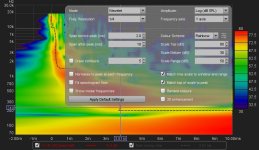Murph
I have a test signal to check the time offset between two drivers. You play the signal on a DVD, Disc player, and pickup the acoustic signal with a mic or RS sound level meter and display the result on a scope. See:
www.donpatten.com
I have a test signal to check the time offset between two drivers. You play the signal on a DVD, Disc player, and pickup the acoustic signal with a mic or RS sound level meter and display the result on a scope. See:
www.donpatten.com
Last edited:
Use pink noise and greatest null
Just a very late experimenter's addendum: This is hardly original, and I probably learnt it elsewhere here but...
This is a Unity (Yorkville U15) horn if that affects anything?
My system is all active EQ-ed. I've tried different tweaks over the years, including use REW to measure and set up. But I haven't had much luck measuring the phase reliably, due to lack of equipment and skill. After doing the obvious (and easy, relatively speaking) like level-matching drivers and overall EQ, I tinker with phase/timing. I am most concerned with HF since that is where hearing is most sensitive. My mids/tweeter xover is 1 KHz.
My latest alignment was to use 1/3 octave pink noise at 1000 Hz, play looped, one driver inverted of course, adjust delay for least bright sound. Curiously, this was with 0 mSec delay. And I did lots of hunting around up to the theoretical max of maybe 0.56 mSec (calculated difference between mid/high). The deepest null, which I am assuming is the least highs (less bright), was 0 mSec.
I don't know if my method is valid, but it seems as good as other similar "hunt the null" methods. You are free to call my method the "Not too bright" method 😀
Just a very late experimenter's addendum: This is hardly original, and I probably learnt it elsewhere here but...
This is a Unity (Yorkville U15) horn if that affects anything?
My system is all active EQ-ed. I've tried different tweaks over the years, including use REW to measure and set up. But I haven't had much luck measuring the phase reliably, due to lack of equipment and skill. After doing the obvious (and easy, relatively speaking) like level-matching drivers and overall EQ, I tinker with phase/timing. I am most concerned with HF since that is where hearing is most sensitive. My mids/tweeter xover is 1 KHz.
My latest alignment was to use 1/3 octave pink noise at 1000 Hz, play looped, one driver inverted of course, adjust delay for least bright sound. Curiously, this was with 0 mSec delay. And I did lots of hunting around up to the theoretical max of maybe 0.56 mSec (calculated difference between mid/high). The deepest null, which I am assuming is the least highs (less bright), was 0 mSec.
I don't know if my method is valid, but it seems as good as other similar "hunt the null" methods. You are free to call my method the "Not too bright" method 😀
Last edited:
Using REW to determine time delays
Hi,
there is useful article on Klipsch forum using REW. I don't understand all of the article, but the main part is after taking the measurement to change the Spectrogram view using the settings in the image below (taken from post 2 on page 2). This should enable you to see the respective crossover points and their relative delays.
Using REW to Determine Time Delays Between Drivers - Technical/Modifications - The Klipsch Audio Community
Hope you find it useful.
Hi,
there is useful article on Klipsch forum using REW. I don't understand all of the article, but the main part is after taking the measurement to change the Spectrogram view using the settings in the image below (taken from post 2 on page 2). This should enable you to see the respective crossover points and their relative delays.
Using REW to Determine Time Delays Between Drivers - Technical/Modifications - The Klipsch Audio Community
Hope you find it useful.
